
How to Implement Salesforce Data CloudHow to Implement Salesforce Data Cloud
Implementing Salesforce Data Cloud can significantly enhance your organization’s ability to leverage customer data for personalized experiences and data-driven decision-making. Here’s a comprehensive guide to help you successfully implement Data Cloud:
1. Assess Your Current Data Landscape
- Audit existing data sources and systems
- Identify data silos and integration challenges
- Evaluate data quality and consistency across sources
- Define your key business objectives for implementing Data Cloud
2. Plan Your Data Strategy
- Define your ideal customer profile and data model
- Identify key customer attributes and behaviors to track
- Establish data governance policies and procedures
- Create a data cleansing and standardization plan
3. Set Up Your Salesforce Environment
- Enable Data Cloud:
- Contact your Salesforce account executive to enable Data Cloud for your org
- Ensure you have the necessary licenses and permissions
- Configure Data Cloud Settings:
- Set up your Data Cloud instance in Salesforce Setup
- Configure data sharing settings and user access permissions
4. Data Ingestion and Integration
- Connect Salesforce Data Sources:
- Set up connectors for Sales Cloud, Service Cloud, Marketing Cloud, etc.
- Configure data sync settings and frequency
- Integrate External Data Sources:
- Use MuleSoft or other integration tools to connect external systems
- Set up API connections for real-time data streaming
- Implement Data Transformation:
- Set up data mapping and transformation rules
- Implement data cleansing and enrichment processes
5. Identity Resolution and Profile Unification
- Configure identity resolution rules
- Set up matching criteria for customer profiles
- Test and refine the identity resolution process
6. Segmentation and Activation Setup
- Create your initial customer segments using the Segment Builder
- Set up real-time segmentation rules
- Configure segment activation across your marketing and engagement channels
7. Analytics and AI Configuration
- Set up Einstein Analytics for Data Cloud insights
- Configure AI models for predictive scoring and next best actions
- Create custom dashboards for key customer metrics
8. Testing and Validation
- Conduct thorough testing of data ingestion and transformation processes
- Validate identity resolution and profile unification accuracy
- Test segment creation and activation across channels
- Verify data privacy and consent management functionalities
9. User Training and Adoption
- Develop training materials for different user roles (marketers, analysts, IT)
- Conduct hands-on training sessions for key users
- Create a Data Cloud center of excellence within your organization
10. Go-Live and Monitoring
- Plan a phased roll-out of Data Cloud capabilities
- Set up monitoring for data quality, system performance, and user adoption
- Establish a feedback loop for continuous improvement
Conclusion
Implementing Salesforce Data Cloud is a transformative journey that requires careful planning, execution, and ongoing optimization. By following these steps, you can set up a robust foundation for leveraging your customer data to drive personalized experiences and data-driven decision-making across your organization.
For expert guidance on implementing Salesforce Data Cloud in your specific business context, click here.

